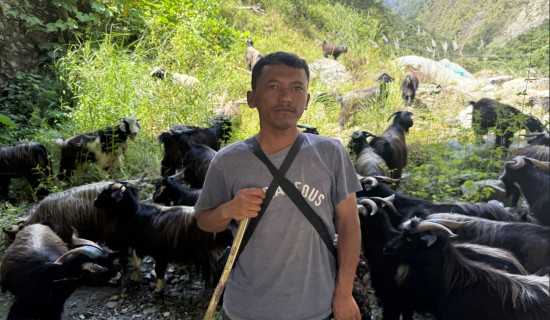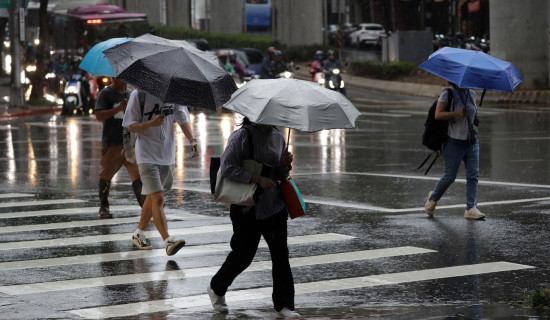- Thursday, 25 September 2025
Kumari Festival In Dolakha
Prof. Shyam Joshi
Similarly, there is the need of a group of thirteen persons for Kumari festival. They play the characters of Bhairav, Kumari, and their attendants such as horse - rider, nose - cutter, weaver, net – thrower, porter, Gubaju and so on. However, Gubaju and the porter carrying kharpan take part only from the second day of the festival. The attendants dance in their own way and they proceed to the festival routes always before Bhairav and Kumari. Only the family members of Gharti clan can take part in this festival. Persons who take part in the dance does not eat any food that day to keep themselves pure. In past this festival was alternatively taken out three years from a house of Tasicha toal and three years from a house of Pingal toal.
Bhairav with black mask dresses fully in black, decorates in ornaments offered by devotees and covers back with long black hair. Likewise, Kumari with red mask dresses fully in red and wears ornaments. The masks are made of cloth and wax.
Because of their appearance, they are called “Black Kumari” and “Red Kumari.” Masks they wear are polished and painted every year but have not been changed since they were made. It is said that once people attempted to replace the old masks by copper mask which could not materialize since the new masks could not create divine vibe.
Rituals
On the day of Dwitiya, the trustee of the festival and the actors of the festival worship in the Bal Kumari temple and make goat sacrifice praying for the success of the festival. The trustee takes red and black tika from the temple and puts on the masks of Bhairav and Kumari stored safely. Thereafter the masks are taken out of the store. On the first day the Jatra is taken out without any fanfare; the team member is incomplete, there is no Linga and the masks are also not decorated and very few people observe the festival. It is believed that on the first day of the start of the festival ghosts and spirits had disturbed the festival.
The Bhairav – Kumari dance starts full - fledged with full team from the second day with decorated masks and Linga tied to Bahirav’s body. First the person known as Jaisi submits (sangkalpa) the offerings made by the fasting women to Bhairav and Kumari and then both of them are given Sagun of boiled egg.
During that time, the music players staying in the courtyard play specific music known as Sagun Baja. After the manager known as Kajit put on turban on their heads they wear mask and get ready to go out for dance. First, Gubaju, supposed to drive away the ghosts and sprits on the route of the festival, goes out and then attendants in different characters go out and dance in the courtyard of the house.
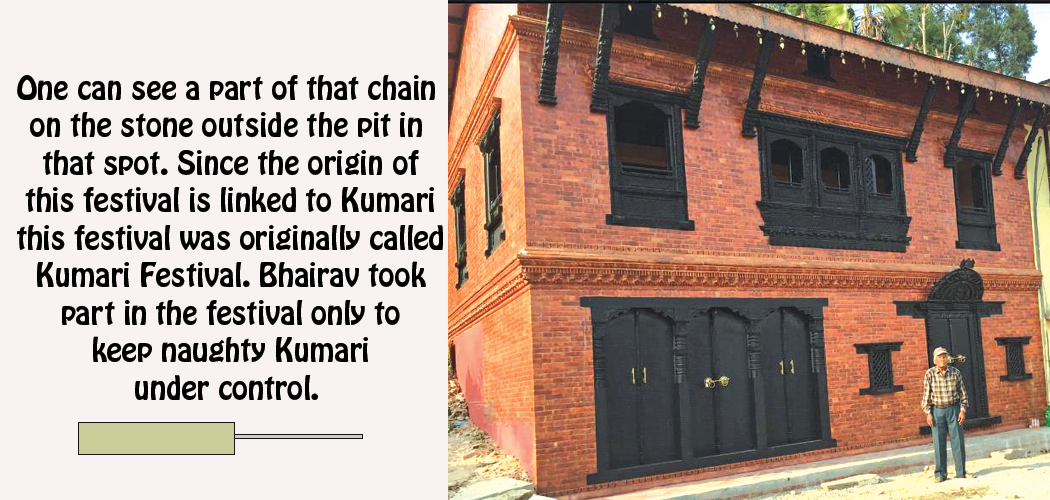
Finally, Bhairav followed by Kumari goes out of the house and begins to dance. When they come out the music changes for their dance. The Kumari dance is then taken all around Dolakha town without skipping the temples of the main deities located in different parts of the town. In front of every temple Bhairav and Kumari must dance traditionally specified “Pahar” (times), the duration of which is determined by the Dholak player. He lengthens or shortens the Pahar taking into consideration the time constraint. From the stupa of Tallo toal and Sarachuka of Mathillo toal Bhairav whistles loudly which is taken as Bhairav signaling another god known as Sahardeu located south-west of the town for help.
From the second day, a Linga is tied to the chest of the person playing the character of Bhairav which is carried by another person throughout the night.
The legend is that if ghost and spirits come on the route and the tantric (Guvaju) is unable to control them Bhairav drives them out
with his openly displayed scary Linga. The Linga is made of copper and is of about one and half meter long.
Blessings of Kumari
People of all houses of Dolakha town worship these deities everyday with great devotion when they arrive nearby their houses. People believe that their every problem can be solved with the blessings of Bhairav and Kumari. It is believed that if a person is suffering from chronic illness or if a house is hunted the problems are solved when Bhairav touches that person or enters the haunted house.
Women take fasting and worship the deities praying for the elimination of their problems and for the prosperity of their family. Some people, for the eternal peace of their deceased family, torch petromax, some light incense sticks and raw incense and go along with Bhairav and Kumari throughout the night.
Particularly on the day of Panchami Dolakha town is crowded with pilgrims from far and wide to observe this festival. People begin to assemble in Dolakha town from afternoon. Hence, people of Dolakha arrange various kinds of shows such as street dramas, dances, and comics to entertain the pilgrims. Bhairav always walks forward before Kumari with a view to control Kumari from doing mischievous deeds and troubling people. Hence, in many places after departure of Bhairav, Kumari acts few minutes in a way as if she is searching for Bhairav. At this time only Sanai is played making the environment little bit melancholic.
It is spectacular to observe the dance early in the morning when Bhairav and Kumari are preparing to enter the house. There is a ritual that Bhairav and Kumari should enter the house before crows begin to fly.
A melancholic traditional music is played at that time. First Bhairav enters the house reluctantly after entering and coming out of the door several times. After that Kumari acts as if she is searching Bhairav in every nook and corners. Like Bhairav she enters the house reluctantly after entering and coming out of the door several times.
The festival comes to an end on the day of Khasti. After the end of the festival people of Gharti clan who took part in the festival arrange a feast for the participants. They spend the money collected as Bheti from the devotees during the festival for this feast. Besides, the provision of Guthi land has also been made from time immemorial for running this festival every year.
Temple of Goddess
The temple of Bal Kumari is situated in a place south - east of Dolakha town surrounded by trees and shrubs. The place known as the temple of Bal Kumari is called “Kobideu” in local language meaning the god of the lower place. According to Dhanbajra Bajracharya and Tek Bahadur Shrestha (Dolakha ko Yatihasik Ruprekha, 2031) – “Here is no special idol of the god; this spot is in the form of Pith. Here the Toran- shaped god is worshipped.”
Bal Kumari temple, where nobody except those with dikshya are allowed to enter, has neither a temple as such nor any image of goddess except an iron chain tied to the ground. However, the people of Sibabhakti clan enter there since they regard that place as the temple of their Kul Debata. No households of Dolakha eat feast without setting aside Thapan (feast) ” to Kobideu in the main festivals such as “Dasai”, “City Nakhat” and “Mage Sankranti. The Thapan is sent through others who are illegible to enter the temple.
Origin of the festival
There are several legends regarding the origin of Kumari festival. One of the legends is that three devis - Kalinchowk Bhagawati, Tripura Sundari and Bal Kumari, while they were taking bath in river Tamakoshi, were seen by two tantric brothers of Dolakha. Two brothers identifying them as goddess persuaded them to reside in various parts of Dolakha. Among the three sisters, Bal Kumari was settled in the current location Kobideu of Dolakha town.
As mentioned in Hindu sacred books Tripura Bala, one of the three forms of Goddess Tripurasundari, is a young virgin goddess. Adolescent Bal Kumari was little bit mischievous and used to loiter in the bazar area and did mischievous acts. In course of time, she began to loiter in the bazar dressed in red and occasionally used to kill and eat children. Her sister Tripura Sundari was unable to keep her under control.
People began to consult among themselves to get rid of the menace of Bal Kumari. They invited a Gubaju from Patan. Gubaju by using his tantric knowledge persuaded Kumari to go inside a pit saying that he will accompany her. He tied her with iron chain and linked with her iron chain tied deceptively himself with flour chain to assure her. She jumped into the pit, but Gubaju was left on the ground above due to weak flour chain. As soon as she fell Gubaju covered the pit with great stone and left the top of the iron chain tied to the stone.
Till today one can see a part of that chain on the stone outside the pit in that spot. Since the origin of this festival is linked to Kumari this festival was originally called Kumari Festival. Bhairav took part in the festival only to keep naughty Kumari under control.
Because of this during the festival Bhairav does not permit Kumari to go ahead of him. Always Kumari follows Bhairav though their attendants go ahead of them. However, some people link the origin of this festival to Bhairav but with the same legend.
After Kumari was locked inside a pit a woman named Shiba Laxmi of Gharti clan began to trouble the people of the town and presumably killed their children. Shiba Laxmi, while punishing her by the locals, confessed that she is, in fact, Bal Kumari and not the child - slayer as they think to be.
After her confession Gubaju identified the troublemaker as Bal Kumari. Then as repentance for cheating goddess Kumari he promised to take out the festival of Bal Kumari along with her spouse Bhairav and their attendants and take around the town once in a year for five days. Meanwhile Shiba Laxmi suggested the complete procedure of taking out the festival and gave order to involve only the members of Shibabhakti clan in the festival. Due to this, till today only the family members of Gharti clan take part in this festival. But even within this clan some family takes part only as Bhairav and some family takes part only as Kumari in the festival.
No one knows the exact date of the start of this festival. However, according to late Prof. Bal. K. Joshi (Bhairav – Kumari ko Shristi Ra Jatra, Hamro Sanskriti, 2024, Phalgun) – “as said by elderly people this festival had been started in about 1782/ 83 B.S”. It has been inscribed in one of the silver garlands of Bhairav and of Kumari that these necklaces were offered by the Chitra Narsingh of Kathmandu and Bidyananda of Dolakha in 1848 B.S. and 1898 B.S. respectively. This indicates that the festival had started much before this, during the reign of some Malla kings of Dolakha.
(The writer is an expert on Nepali culture)

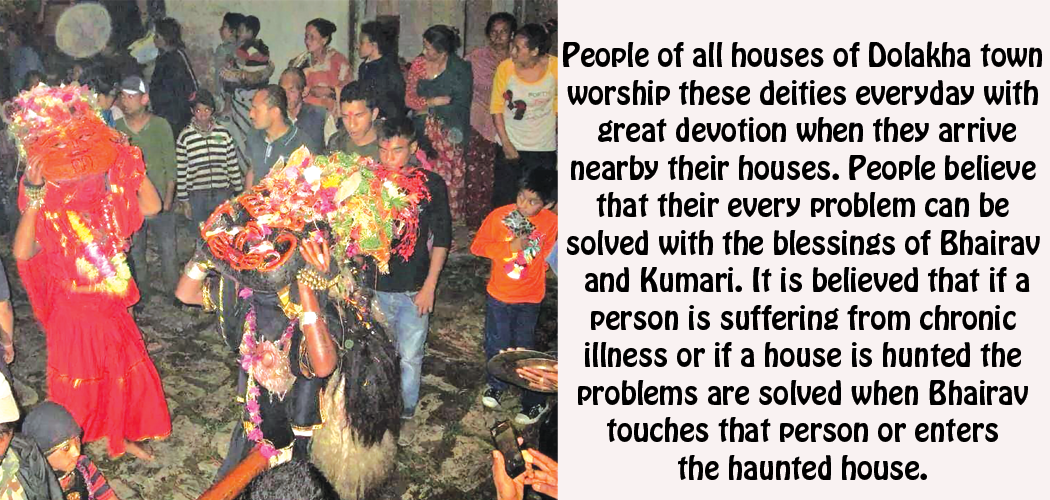

-original-thumb.jpg)

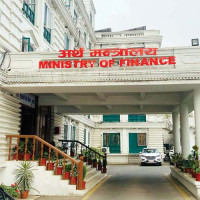
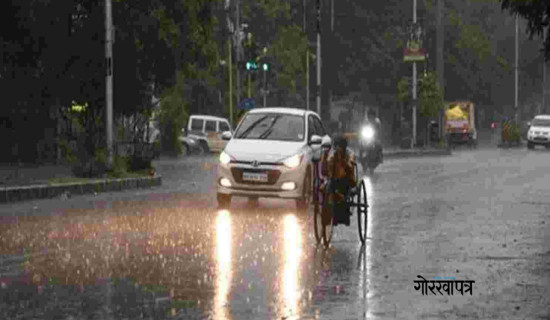


-original-thumb.jpg)

